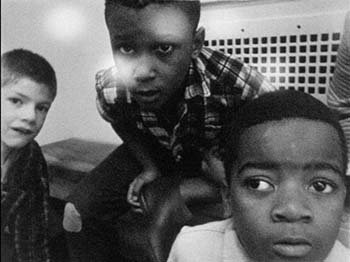Film Scratches: Receiving a Face – Scrapbook (2015)

Film Scratches focuses on the world of experimental and avant-garde film, especially as practiced by individual artists. It features a mixture of reviews, interviews, and essays.
A Review by David Finkelstein.
Scrapbook is a haunting and fascinating 19-minute short by Mike Hoolboom, based on footage shot in 1967 at Broadview, an Ohio residential facility for developmentally disabled children. The 16mm footage was shot by Jeffrey Paull, who had been hired to teach photography to the kids as a form of therapy. (Paull was one of Hoolboom’s film professors in the 1980s.) Hoolboom managed to locate a woman who had lived there as a kid and had known Paull, and he asked her to watch the footage and record her reactions. This woman, Donna Washington, had remarkable insights into the footage and about her childhood experiences at Broadview, and her (edited) comments, combined with the (edited) footage, make up the film, accompanied by Stephan Mathieu’s music. The music is an eerie collage of children’s voices, electronic sounds, and sustained tones that might be played on toy instruments, perfectly creating the texture of the strange, altered world inhabited by the kids.
 Generally speaking, the kids look remarkably happy, considering that they live in an institution. One boy dances joyfully as he sweeps a room with a broom. Their childish exuberance isn’t suppressed here. They are all fascinated by the camera and crowd around it. One sugar-addicted kid is obsessed with licking syrup off of a pancake, rather than eating the pancake itself. A few kids are seen rocking or engaging in typically repetitive autistic behavior. It is clear that they feel safe and well-cared for, which may mean that Broadview was unusual. The adult staff members we see are openly affectionate with the kids. But these happy faces are qualified by Washington’s explanation of what they may be masking. She explains how laughter was more often a sign of fear than joy, and we see a laughing boy who then covers his face, clearly demonstrating her point.
Generally speaking, the kids look remarkably happy, considering that they live in an institution. One boy dances joyfully as he sweeps a room with a broom. Their childish exuberance isn’t suppressed here. They are all fascinated by the camera and crowd around it. One sugar-addicted kid is obsessed with licking syrup off of a pancake, rather than eating the pancake itself. A few kids are seen rocking or engaging in typically repetitive autistic behavior. It is clear that they feel safe and well-cared for, which may mean that Broadview was unusual. The adult staff members we see are openly affectionate with the kids. But these happy faces are qualified by Washington’s explanation of what they may be masking. She explains how laughter was more often a sign of fear than joy, and we see a laughing boy who then covers his face, clearly demonstrating her point.
Our experience of this footage is constantly mediated by Washington’s commentary, which is read by actress Martha Cronyn. Speaking of the experience of seeing herself as a child in the film, she remarks “I’m not sure if I’m ready to meet her again.” She describes emotions themselves as being overwhelming. As a result, she says, all emotions, whether positive or negative, scared her, so fear dominated everything.
 She speaks of the experience of sensory overload, so common to some mentally different people who have no ability to screen out sensations: “It may look like an empty room to you, but to me there is so much going on.” We see a girl who is overwhelmed by the camera’s gaze and covers her eyes with her arm.
She speaks of the experience of sensory overload, so common to some mentally different people who have no ability to screen out sensations: “It may look like an empty room to you, but to me there is so much going on.” We see a girl who is overwhelmed by the camera’s gaze and covers her eyes with her arm.
It becomes clear from some of her remarks just how powerfully transformative it was for her to meet Paull and learn photography from him. “Jeff was a sad young man who always smiled, and he came every day to show us how to see ourselves with the camera.” “He taught me a lot about how to see a face, how to receive a face.” Essentially, the photography work helped her unravel the mysteries of identity, of understanding the difference between herself and others, of understanding what people see when they look at her. Hoolboom’s editing of this footage, and pairing it judiciously with Washington’s remarks, has a lot to teach all of us about how to receive a face.
David Finkelstein is a filmmaker, musician, and critic. For more information on Film Scratches, or to submit an experimental film for review, contact lakeivan@earthlink.net.